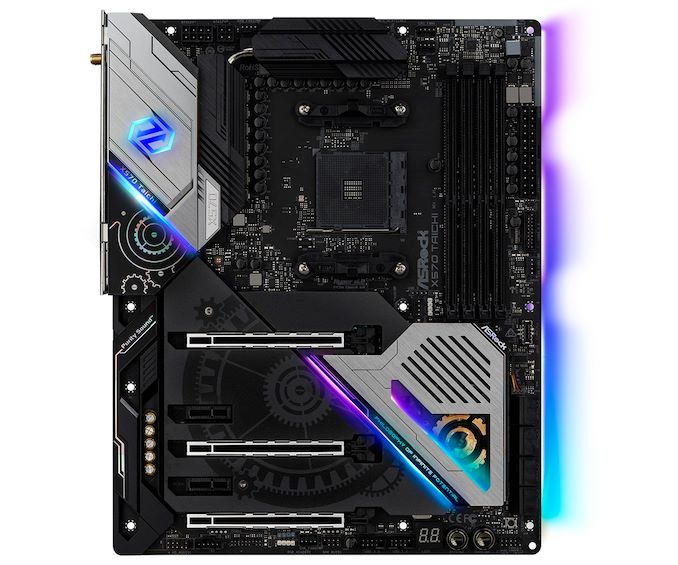The AMD X570 Motherboard Overview: Over 35+ Motherboards Analyzed
by Gavin Bonshor on July 9, 2019 8:00 AM ESTASRock X570 Taichi
Moving a step down the product stack from the X570 Aqua is the ASRock X570 Taichi which includes a new RGB inspired design, and shifts away from the usual black and white Taichi theme. While still targetted at premium users and enthusiasts, the ASRock X570 Taichi is representative of one of its most well-known lines which in previous generations has combined quality, performance, and a solid feature set at a reasonable price point. The ASRock X570 Taichi also uses its fabled signature cogwheel design across the board covers and integrates ARGB into multiple areas.
The ASRock X570 Taichi redefines the range and marks a change in aesthetics across the entirety of the board. On the majority of the board is its memorable cogwheel design is still a main element of the design but it now includes black heatsink armor around the PCIe slot area. The X570 chipset is actively cooled by a fan, mainly due to the X570 chipsets tendency to run warmer than previous generations. On the rear panel cover as with the chipset heatsink is ARGB for users looking to make a visual statement with their system. The X570 Taichi uses a 14-phase power delivery and has one 8-pin and one 4-pin 12 V CPU power inputs.
On the X570 Taichi is three full-length PCIe 4.0 slots operating at x16, x8/x8, and x8/x8/x4, with two PCIe 4.0 x1 slots. Underneath the heatsink armor is three PCIe 4.0 M.2 slots, while the board also supports up to eight SATA devices. For users looking for Thunderbolt connectivity, a Thunderbolt AIC 5-pin connector is present, but support is limited to ASRock's separately supplied AIC card. A total of four memory slots with support for DDR4-4666 are present, with a maximum supported capacity of up to 128 GB.
On the rear panel is a single Intel I211-AT Gigabit port, and also includes the new 802.11ax Killer AX1650 Wi-Fi 6 wireless adapter. There are three USB 3.1 G2 Type-A, a single USB 3.1 G2 Type-C, and four USB 3.1 G1 Type-A ports. An HDMI video output is present for users looking to use the integrated graphics on Ryzen APUs, while there's five 3.5 mm color coded audio jacks and S/PDIF optical output which is powered by a Realtek ALC1220 HD audio codec. For legacy users, a PS/2 combo port is featured, along with a BIOS Flashback button and a button to reset the CMOS.
The ASRock X570 Taichi has an MSRP of $300 and represents one of its most recognisable ranges for the last decade. Users looking for a mid-range option with plenty of features including triple PCIe 4.0 x4 M.2 slots, plenty of SATA, and solid power delivery will be hard pushed to find a better board in its price range.












225 Comments
View All Comments
mikato - Thursday, July 11, 2019 - link
That’s great to hear. I wonder why they don’t put a decent heatsink on there like they did a long time ago (Penguin 4 days maybe). Is it still too much heat for a big heatsink with no fan?Makaveli - Tuesday, July 9, 2019 - link
Thank you for this round up and more importantly the summary page at the end.I think I going with the ASUS Prime X570-Pro for my build, its the most affordable in CAD.
Never was interested in Wifi on a Desktop PC yuck and the rest if just way too over priced.
I do like the simple look of the ASUS Pro WS X570-Ace but for $500 CAD not interested at that price you might aswell go Threadripper.
Andy Chow - Tuesday, July 9, 2019 - link
I still don't understand why all these boards have HDMI and/or DP on them. Virtually every Intel consumer CPU has an iGPU in it, so it makes sense there. For AMD, I want MOAR CORES, not an iGPU. So that's 1-2 ports that will never get used, which could have been a couple of usb-3 ports.Qasar - Tuesday, July 9, 2019 - link
i bet they are for future zen 2 based APUs....Qasar - Tuesday, July 9, 2019 - link
or current ones for that matterDeath666Angel - Wednesday, July 10, 2019 - link
Because AMD also has iGPU enabled CPUs (which they call APUs). And economies of scale being what they are, this makes more sense than having separate SKUs. Also, do you actually use up all 8 to 12 USB ports on the back?The_Assimilator - Wednesday, July 10, 2019 - link
It's so that the manufacturers can get more negative reviews on online shopping sites. "I BOUGHT THIS BOARD BECAUSE IT HAS DISPLAY OUTPUTS BUT THEY DON'T WORK SO I'M GIVING IT 1 STAR EVEN THOUGH I DIDN'T BOTHER TO DO THE 5 MINUTES OF RESEARCH IT WOULD'VE TAKEN TO EDUCATE MYSELF AS TO WHAT I NEED FOR THE DISPLAY OUTPUTS TO WORK".I agree with you that more USB ports instead would be a lot more useful.
mikato - Thursday, July 11, 2019 - link
Upvoteboozed - Tuesday, July 9, 2019 - link
The last page is a godsend, more of this kind of thing please!NOTELLN - Tuesday, July 9, 2019 - link
This data is wrong. These are not the proper core counts. For example, the International Rectifier IR35201 PWM controller can only do 8+0, 7+1, or 6+2, making the MSI pro and gaming plus 4+2 phase boards. You boys need to go back to the drawing board.